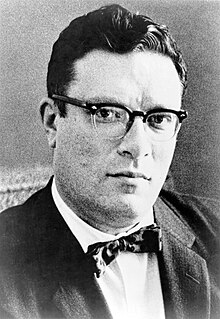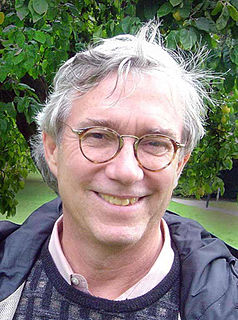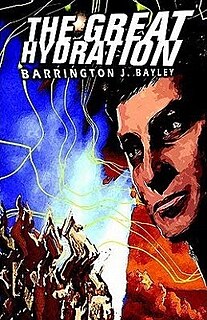
Isaac Asimov was an American writer and professor of biochemistry at Boston University. During his lifetime, Asimov was considered one of the "Big Three" science fiction writers, along with Robert A. Heinlein and Arthur C. Clarke. A prolific writer, he wrote or edited more than 500 books. He also wrote an estimated 90,000 letters and postcards. Best known for his hard science fiction, Asimov also wrote mysteries and fantasy, as well as much nonfiction.
The Galactic Empire series is a science fiction sequence of three of Isaac Asimov's earliest novels, and extended by one short story. They are connected by their early place in his published works and chronological placement within his overarching Foundation universe, set around the rise of Asimov's Galactic Empire, between the Robot and Foundation series to which they were linked in Asimov's later novels.

Rudolf von Bitter Rucker is an American mathematician, computer scientist, science fiction author, and one of the founders of the cyberpunk literary movement. The author of both fiction and non-fiction, he is best known for the novels in the Ware Tetralogy, the first two of which both won Philip K. Dick Awards. Until its closure in 2014 he edited the science fiction webzine Flurb.
Michael Lawson Bishop is an American writer. Over four decades and in more than thirty books, he has created what has been called a "body of work that stands among the most admired and influential in modern science fiction and fantasy literature."
Biopunk is a subgenre of science fiction that focuses on biotechnology. It is derived from cyberpunk, but focuses on the implications of biotechnology rather than mechanical cyberware and information technology. Biopunk is concerned with synthetic biology. It is derived of cyberpunk involving bio-hackers, biotech megacorporations, and oppressive government agencies that manipulate human DNA. Most often keeping with the dark atmosphere of cyberpunk, biopunk generally examines the dark side of genetic engineering and represents the low side of biotechnology.

Lucky Starr is the hero of a series of science fiction books by Isaac Asimov, using the pen name "Paul French" and intended for children.
The first Golden Age of Science Fiction, often recognized in the United States as the period from 1938 to 1946, was an era during which the science fiction genre gained wide public attention and many classic science fiction stories were published. In the history of science fiction, the Golden Age follows the "pulp era" of the 1920s and 1930s, and precedes New Wave science fiction of the 1960s and 1970s. The 1950s are a transitional period in this scheme; however, Robert Silverberg, who came of age in the 1950s, saw that decade as the true Golden Age.

Paul Di Filippo is an American science fiction writer. He is a regular reviewer for print magazines Asimov's Science Fiction, The Magazine of Fantasy and Science Fiction, Science Fiction Eye, The New York Review of Science Fiction, Interzone, and Nova Express, as well as online at Science Fiction Weekly. He is a member of the Turkey City Writer's Workshop. Along with Michael Bishop, Di Filippo has published a series of novels under the pseudonym Philip Lawson.
Paul Cook is an American science fiction writer and classical music critic. He is a Principal Lecturer in the English Department at Arizona State University.

Dogland is a fantasy novel by Will Shetterly, a fantasy and comic book writer. Published in June 1997, it is the novel Shetterly is most proud of. Dogland placed thirteenth in the annual Locus poll for best fantasy novel. The story is based on his own childhood and a tourist attraction that his parents owned called Dog Land. In 2007 Shetterly published a sequel, The Gospel of the Knife.

Year's Best SF 8 is a science fiction anthology edited by David G. Hartwell and Kathryn Cramer that was published in 2003. It is the eighth in the Year's Best SF series.
Chris Beckett is a British social worker, university lecturer, and science fiction author. He has written several textbooks, dozens of short stories, and six novels.

The Robert E. Howard Reader is a collection of essays on fantasy writer Robert E. Howard and his works, edited by Darrell Schweitzer. Originally scheduled for publication in 2007, it was ultimately published in September 2010 by Wildside Press.
Mark Hodder is an English author, since 2008 living in Spain. His six-part series of 'Burton & Swinburne' steampunk novels opened with The Strange Affair of Spring-Heeled Jack, which went on to win the 2010 Philip K. Dick Award. The following two novels, The Curious Case of the Clockwork-Man and Expedition to the Mountains of the Moon, were released in 2011 and 2012 respectively to wide acclaim from fans of the genre, with the latter nominated for a Sidewise Award. His fourth novel in the Burton & Swinburne series, The Secret of Abdu El Yezdi, was also nominated for a Sidewise Award.

The Great Hydration is the sixteenth and last science fiction novel by Barrington J. Bayley. The book was written in 1998 and first published as a print on demand edition in 2002. The book features the illegal traders Krabbe and Bouche, the first humans to reach the planet of Tenacity, as they proceed to destroy the planet's anhydrous economy in an attempt to make a quick profit.

The Astounding, the Amazing, and the Unknown is an alternate historical adventure novel written by Paul Malmont, the sequel to The Chinatown Death Cloud Peril (2007). It features real-life pulp magazine authors of the past as the heroes of adventures reminiscent of their favored genres. The book was first published in hardcover by Simon & Schuster and audiobook by Brilliance Audio in July 2011. The title is drawn from those of the magazines, Astounding Science-Fiction, Amazing Stories, and Unknown, for which his main protagonists wrote.
"Danny Goes to Mars" is a science fiction short story by American writer Pamela Sargent. It was first published in Isaac Asimov's Science Fiction Magazine, in October 1992.
Child of the Light is a novel by Janet Berliner and George Guthridge published by White Wolf in 1991.
Humility Garden is a novel by Felicity Savage published by ROC in 1995.
Suzanne Palmer is a writer of science fiction known for her novelette "The Secret Life of Bots" which won a Hugo Award in 2018. The story also won a Washington Science Fiction Association Small Press Award, and was a finalist for the Theodore A. Sturgeon Memorial Award.









